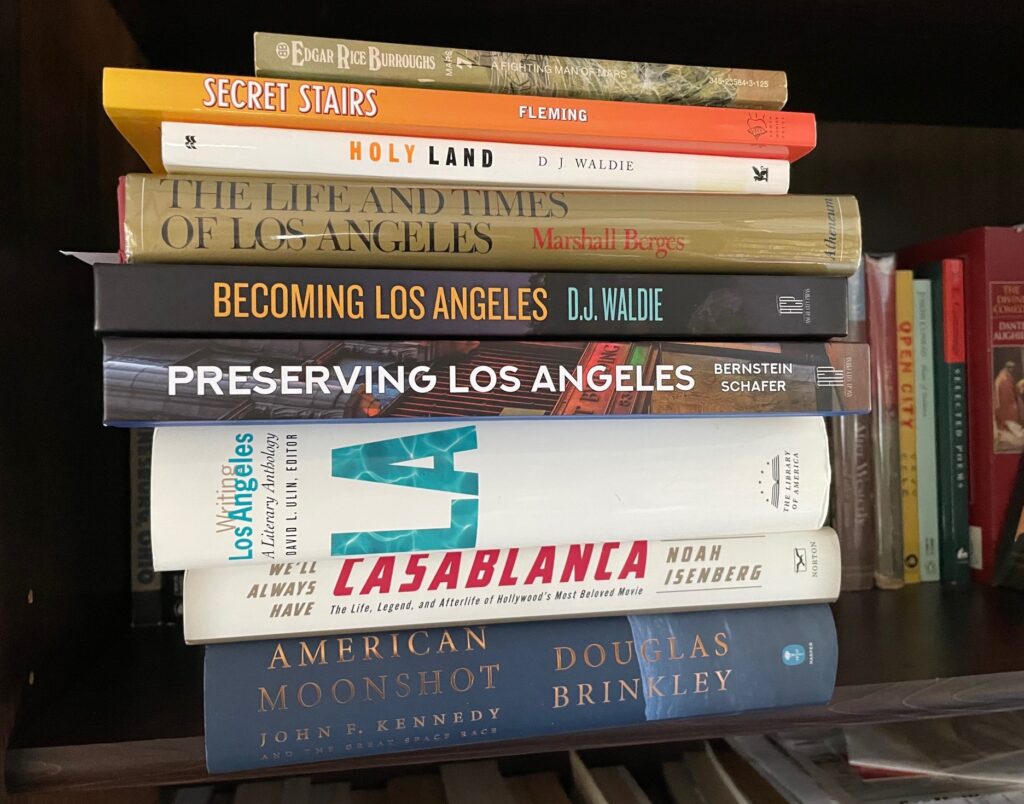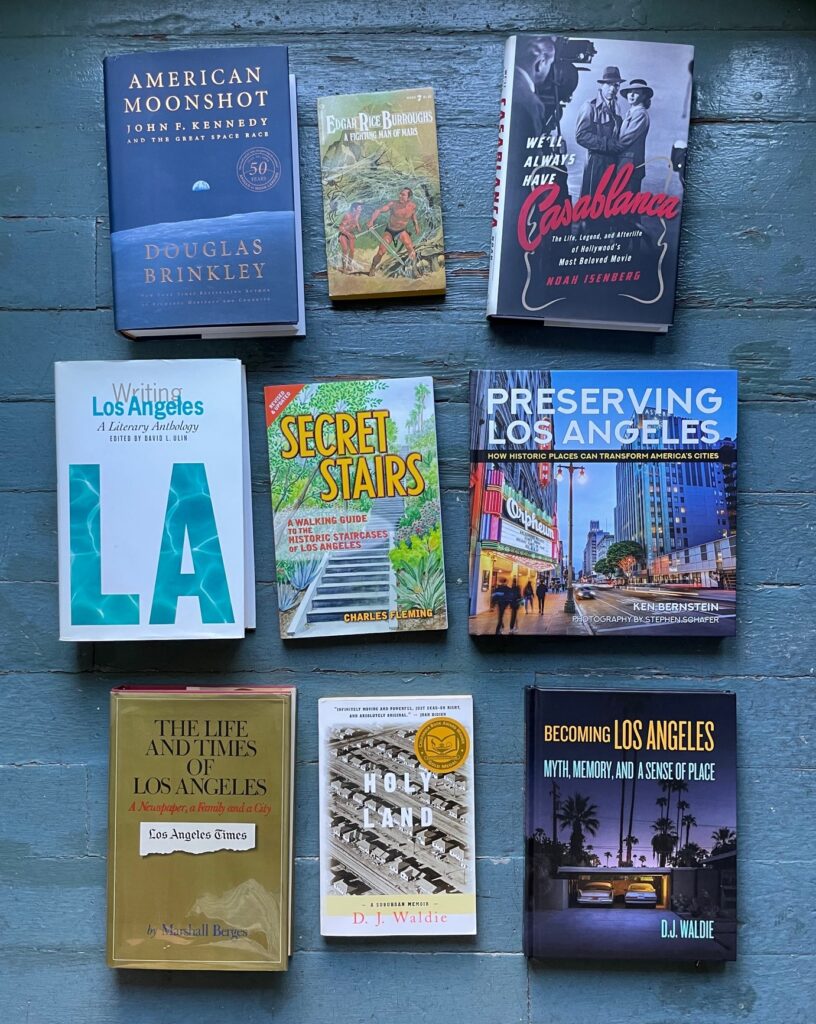Taco Tia literally means Taco Aunt, which of course makes no sense. But the alliteration sounds good, and that was the logic behind it in 1954. I write about the mini-chain, now down to one location, as well as about the next KCRW Tortilla Tournament and a beloved sign’s absence in Upland, in Sunday’s column.
Monthly Archives: September 2021
Column: Barris shop to leave NoHo and take Batmobile with it
I take a tour of Barris Kustom Industries, the North Hollywood home of the late car customizer George Barris’ operations, which will soon be closing up shop and moving to Ventura County. That’s the subject of my Friday column.
Column: Alta Magazine finds Inland Empire angles again
My favorite quarterly, Alta Magazine, touches on the IE in various places in its latest issue, teaching even your columnist a few things — which I pass along to you at no charge. Also, I write about my Labor Day weekend in the San Fernando Valley, an upcoming personal appearance in Riverside (my first) and, gulp, a local angle involving Sirhan Sirhan. All this is in Wednesday’s column.
Reading Log: August 2021
Books acquired: none
Books read: “We’ll Always Have Paris,” Noah Isenberg; “American Moonshot,” Douglas Brinkley; “Secret Stairs,” Charles Fleming; “A Fighting Man of Mars (John Carter #7)”, Edgar Rice Burroughs; “Writing Los Angeles,” David Ulin, editor; “Preserving Los Angeles,” Ken Bernstein; “Becoming Los Angeles,” “Holy Land,” D.J. Waldie; “The Life and Times of Los Angeles,” Marshall Berges
In the eighth month of 2021, I cut loose with nine books, surprising myself. It helped that I listened to three of them on audiobook (despite owning copies). That sure speeded things up. They make for a tall stack, especially with a couple of fat hardcovers in the mix.
Eight of the nine are nonfiction, another surprise, since I was concentrating on fiction this year. Well, 7 1/2 — “Writing LA” is a mix of fiction and non. Let’s go to my capsule summaries.
“Casablanca” (2017): Isenberg surveys the film from multiple angles: its genesis, its production, its impact and its afterlife. Even as a fan of the film, I learned a few things, such as how many of the plot points and lines of dialogue were lifted from the unproduced play it was based on, and how many actors and bit players were refugees themselves. That said, this book isn’t the place to go for, say, a feminist critique; that some don’t like “Casablanca” is barely acknowledged.
“Writing” (2002): This is a nearly 900-page anthology of essays, stories and excerpts going back to Helen Hunt Jackson’s 1883 interview with an aging Californio and ending with David Thomson’s 1997 ode to Mulholland Drive. Included by editor David Ulin are the big names you’d expect (Chandler, Fitzgerald, Didion) and many you wouldn’t. The result presents the region from multiple angles, and serves as a nose-thumb to anyone who thinks we’re too lightweight for literature. If you’re interested in LA, this is the most useful doorstop you’ll ever own.
“Stairs” (2010): 42 urban walks involving public stairways, mostly in Silver Lake, Echo Park, Los Feliz and Hollywood. How do you rate a walking guide? Since I’ve completed every walk, over the course of 10 meandering years, all by carrying the book, this has to be the single most immersive reading experience I’ve ever had. So by my lights, it’s the “Moby-Dick” of urban walking guides.
“Fighting Man of Mars” (1930): An enjoyable entry in the series, with a romance involving a hero who knows nothing of love or the fairer sex, but learns eventually after cluelessly, but charmingly, wondering why his heart is beating faster around the woman he considers his friend. Oh, Hadron of Hastor, you lovable lunkhead! And in a way this book is quite modern: It could just as easily have been titled A Fighting Woman of Mars thanks to the athleticism, bravery and swordplay of Tavia, a bold creation for 1929/30.
“Moonshot” (2019): As part of the Apollo 11-17 generation, I’ve always felt positively about the space program but never appreciated just how much commitment had been required to fulfill JFK’s crazy-expensive 1961 promise to put a man on the moon by the end of the decade. Or how JFK came to make the promise to begin with. Or how ex-Nazi rocketmen and Soviet space aspirations pushed us forward, or how much LBJ backed the space program (and got Mission Control built in his home state of Texas). Brinkley pulls all those threads together into a useful, readable account, published in time for the 50th anniversary of Apollo 11.
“Preserving” (2021): LA’s reputation is ahistorical and concerned more with the future than the past, but Preserving Los Angeles shows the other side, which is the wealth of buildings, neighborhoods and features that have withstood time and real estate cycles to remain nearly intact or find a new use. Bernstein even constructs a guide for exporting LA’s approach elsewhere. It doesn’t make for a lively or lyrical read, but it’s worthwhile if you love LA, and the photo documentation is valuable.
“Becoming” (2020): “Becoming might be the definition of Los Angeles,” Waldie writes. These reflective essays, or “footloose thoughts,” explore such topics as 19th century would-be boomtowns, Spanish Colonial Revival architecture, TV personalities Huell Howser and Tom Hatten, our months without sunshine (May and June), a woman who specializes in selling buttons and the examples of nature encountered on Waldie’s suburban walks. Unassuming, thoughtful.
“The Times” (1984): A breezy look at the LA Times past and present (as of 1984), this includes the paper’s notorious anti-labor position and a few other zingers but is largely a glossy, semi-official account. (Not for nothing is Berges’ previous book “Corporations and the Quality of Life.”) Still, it’s an easy, enjoyable read if the topic is of interest, and if you love newspapers it’s a little poignant, since in 1984 the Times was probably at its peak, with 1 million circulation, 500 pages on Sundays and 850 editorial employees. No one could have guessed the erosion to come.
“Holy Land” (1996): I read this personal and social history of Lakewood, the instant LA suburb, in 2013 and was bemused by its brevity and its 300-plus chapters in under 200 pages. It’s now on audiobook, I borrowed it from the library, and this time through I was delighted. The short chapters, some of which might begin and end while you’re waiting at a stoplight or even while making a left turn, have spareness, poetry and wit that struck me when read aloud. It was probably me, not him, but now I like it.
The standouts of August were “Moonshot,” “Writing” and “Holy Land.” Also, I wrote a column about “Writing,” “Becoming” and “Preserving,” a trio I dubbed “Gerund LA.” Ditto about “Secret Stairs.” Consider them Reading Log bonus features.
When and where did I acquire these books? “Holy” was a library borrow in 2021, “Becoming” was a gift of the author in 2021, “Preserving” was a friend’s gift in 2021, and “Stairs” (third edition) was bought in 2021 at Skylight Books in Los Feliz, with the first edition bought there in 2011. “Moonshot” was a friend’s gift in 2020, “Casablanca” the same friend’s gift in 2018. “Mars” was purchased at the Black Ace Paperback Show in 2011. “Writing” was bought at Moe’s in Berkeley in 2007, the same year I got “Times” at Book Baron in Anaheim. Those two had to age a while on my shelves, obviously.
We’re now two-thirds of the way through 2021, readers. If your year in books is drifting, there’s still time to course-correct. I’m not sure how the rest of my year will go, but I’m likely to settle back more into the five-or-six-a-month range. It was satisfying to finally push through “Writing” after getting to around page 250 via stints here and there through the year; I picked it up again in late July and, as the month turned, decided to just plow ahead and finish. Felt good to get such a large collection in the “read” category.
Next month: The return of Travis McGee.
Column: They really want to know: ‘Do you have a citrus tree?’
In Redlands, strangers apparently ask each other the above question as an ice-breaker. Author Deborah Fallows has a sweet story about it. Also, more about Mentone’s Paul Bunyan, 1909 pennies, Rancho Cucamonga’s former Gilberto’s Lounge and the expansion of Starbucks in Pomona, all in a Sunday column of holiday-weekend leftovers. Happy Labor Day!
Column: Any good LA book has IE tidbits, and these qualify
I read three books about Los Angeles, enjoyed them and teased out Inland Empire references, which I write about in Friday’s column.
Column: Joke flies even if replica of AMLO’s plane won’t
Ah, a good old-fashioned items column. It begins with an explanation of a sculpture in Sunday’s column, continues with some Metrolink news from San Bernardino involving a very late-night train, and ends with a Culture Corner of sorts and a wedding anniversary item involving Pomona. All that’s in Wednesday’s column.


